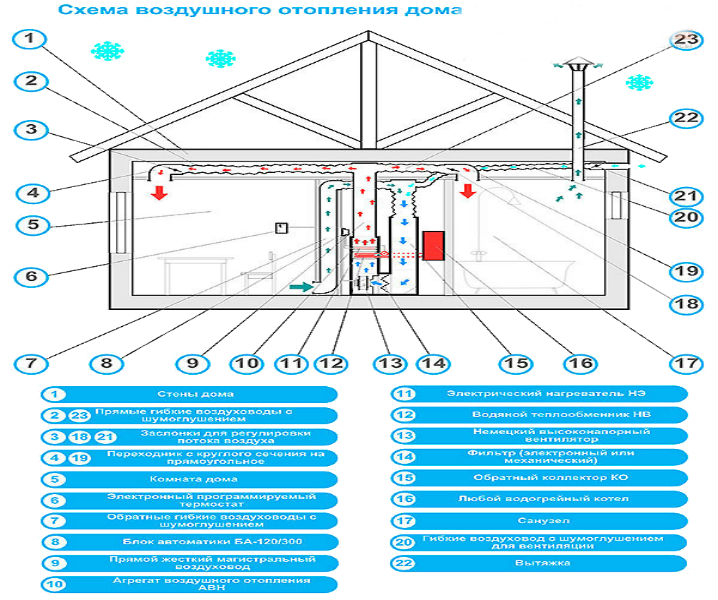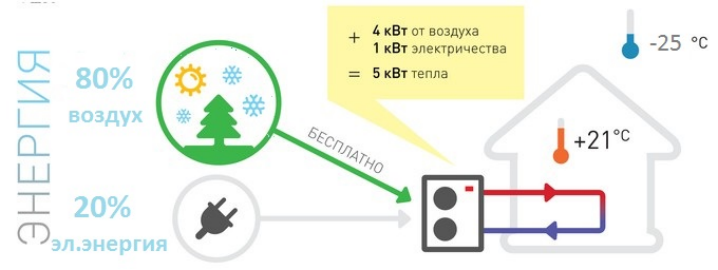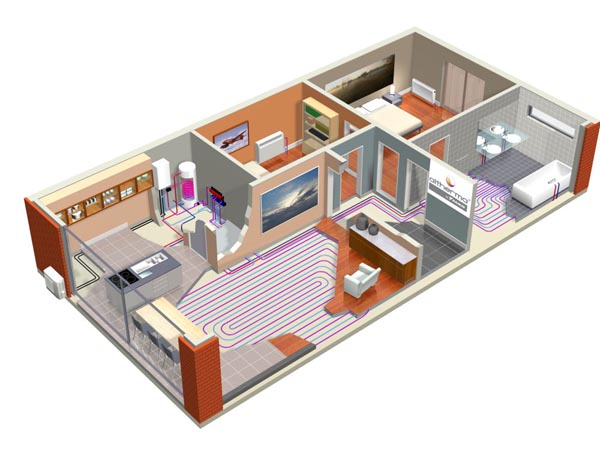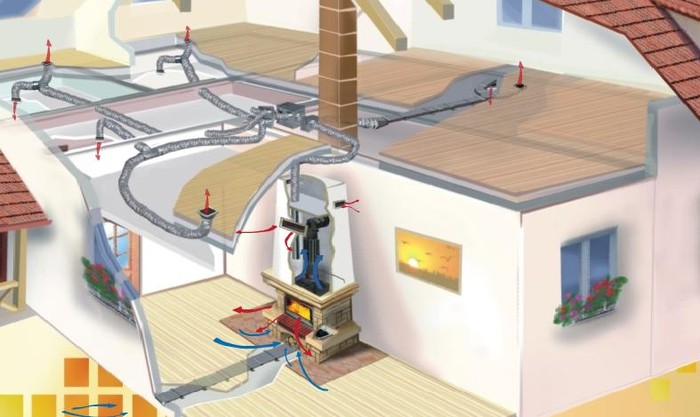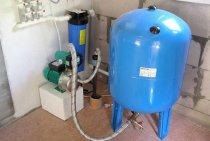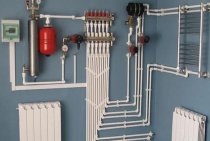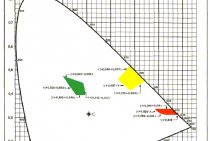Good and bad news ventilation
A person in the course of his activity emits a lot of harmful substances. Even when he sleeps, he breathes and emits carbon dioxide and about 400 other harmful substances. When he cooks food, uses water or plays sports, he pollutes the environment even more. The main task is to throw it all away, primarily air, replacing it with clean.
With proper ventilation in our house, if 3 people live in it, about 100 cubic meters of air per hour will need to be replaced. Many will say that much more is needed, but here I am ready to argue. The removed air leaves together with the heat, and the new air must be heated, and this is at -30 degrees Qvent \u003d 100x50 / 2.98 \u003d 1678 W, i.e. another 33% of additional power.
Where is the good news, you say. There are two of them. I have already mentioned the first one, the norms and principles for calculating ventilation adopted in SNiPs are hopelessly outdated, according to them you would have to spend 3-5 times more energy on ventilation. The second news: modern ventilation systems are able to return part of the heat that leaves with the removed air (this is called recuperation) and reduce the power for heating the air by 2-4 times.
Convectors
The principle of operation is based on the physical laws of convection. Heating elements are located inside the housing, they heat the cold air coming from below, after which it enters the room through openings in the housing. When the convector is on, there is a constant circulation of air masses, the room quickly heats up to the temperature set on the controller, after which the automation turns off the heating until the air cools down.
Convectors are silent, safe, but they mainly heat the air, which in houses built using SIP panel technology cools down at the slightest draft. Heating with convectors is not economical and is mainly suitable for a country SIP at home or as a temporary measure before connecting a heating boiler or stove.
Air heating SIP houses
This type of heating for houses made of SIP panels also consumes electricity, but it needs to be discussed separately.
It is difficult to carry out air heating in the SIP house yourself, so you will need to call a specialist.
However, with this option, resources are saved well, and it is possible to set the temperature regime independently, just as in the case of using an air conditioner.
Air heating of SIP houses and ventilation with an area of more than 250 sq. meters will cost you less than installing water heating.
Advantages of air heating in SIP houses:
- lack of drafts;
- purification of air from dust, mold, smoke and unpleasant odors;
- provide the necessary air humidity;
- receive metered heating flows in SIP crowbars;
- the ability to build the desired air temperature;
- economy.
Electric heating in SIP houses
Heating houses from SIP panels can be done in different ways, but one of the most suitable is the use of electrical devices:
- warm floor;
- radiators;
- convectors.
Sip houses retain warm air in the same way as water is poured into a thermos.
So, an excellent solution would be to buy a "warm floor" system, but it needs to be designed at the construction stage. Underfloor heating is appropriate in homes where heat is retained for a long time, and heating occurs quickly.
One of the benefits of underfloor heating is that it radiates heat from below rather than from the side of the walls. Wall-mounted radiators are not convenient because the heat is directed straight up.
Radiators will be another good option for electric heating of SIP houses.
They are good because you can save on resources without laying a device in each room. If some rooms are not in use, they can be temporarily not heated, which will not affect the temperature in other rooms.
The radiator is easy to control, you can turn the device on or off at any time when the house has already warmed up.Electric heating lasts for a long time, and frequent shutdown of the appliance from the network will not affect wear and tear and will not take a lot of electricity.
Another suitable option for electric heating for sip houses is the purchase of convector equipment.
This type is useful in that it can also be hidden under the floor covering, but when building a house, you need to take this into account so that the space under the floor matches the size of the equipment.
The convector consists of a grid and the device itself, consisting of a heating element. When the device is working, it is silent, besides, the heating will not spoil the appearance, since it will be located inside the floor.
Gas heating
Columns, gas boilers and other powerful equipment are suitable for brick houses, they are designed for large heat losses.
In addition, gas heating in SIP houses can become burdensome in terms of gasification of the house.
The cost of gas heating is not cheap, especially since gas heating in SIP houses requires constant heating.
In connection with the above characteristics, it is inexpedient and unprofitable to install this type in SIP panel houses.
Furnace heating in houses from SIP panels
Stove heating cannot be called unprofitable, but it can only be used for beauty, since it will be difficult to heat the whole house with a stove.
Stove or fireplace heating has already become obsolete and is of little use in modern times.
Heating houses from SIP panels with a stove is very expensive and unhealthy.
No windows, no doors, but according to GOSTs
At first we will not take into account windows, doors and ventilation and we will assume that heat escapes only through standard walls and ceilings.
The area of all external walls is equal to the perimeter multiplied by the height: S=34.75 x 5.54=192.5 sq.m. The area of the lower and upper ceilings is 2 x 75 = 150 sq.m. We take the heat resistance according to GOST: R-walls \u003d 3.0; R-overlap=3.9. Heat loss Qrev \u003d (192.5 / 3 + 150 / 3.9)x50 \u003d 102.63x50 \u003d 5131 W. At -30 degrees outside, the power of heating devices should exceed 5 kW. At a price of 4 rubles / kW * hour for 1 day we will spend 492 rubles, and for a month - as much as 15,000 rubles!
People who have never heated a large house in severe frosts will be horrified by these figures, while those who lived in poorly insulated houses in winter will look at these calculations with optimism and demand proof.
Bad news windows devour heat
According to the standard, windows must have a thermal resistance of 0.5, i.e. they lose heat 6 times more than walls (per 1 sq.m). Our house has 10 large windows (1.25x1.4), 3 small windows (0.6x1.0) and an entrance door, totaling 21.3 sq.m. Losses at -30 degrees: Qwindow \u003d (21.3 / 0.5) x50 \u003d 2130 W. To be precise, we have to reduce the area of the walls, but still get 1775 W, i.e. windows and the front door increase heat loss by another 35%.
Manufacturers of modern windows are trying to improve designs to reduce heat loss. Some claim that their windows have a thermal resistance of R = 0.7 or even 1.0, although independent tests are rarely carried out here in Russia.
Where to start when choosing a heating system
Suppose you are thinking about building a country house or cottage. If you plan to be independent of the weather conditions outside the window and live in the house during the cold season, then the first thing to think about is heating. Without it, it is difficult to imagine comfortable conditions and coziness. Even if the country house was qualitatively insulated during construction, given the climate of our country, heating is indispensable.
Tip: to make it pleasant for your family to be in the house at any time of the year, think about how you will heat your house already at the design stage of your home.
Of course, you can independently deal with the issue of heating the house, but in order to avoid unpleasant consequences, it is better to entrust this process to professionals. They will help you accurately calculate the necessary equipment, and you will not waste your time.
Tip: trust the issue of heating your home only to specialists!
For many people, even the terminology used by heating specialists is unfamiliar, to be sure, about the equipment itself. It is even more difficult to decide on the brand of heating equipment and the necessary parameters. On our website you can get acquainted with various ways of heating a house, choose the right equipment, and also ask our managers for help.
Another good news about SIP panels
SIP panels are warmer than required by GOSTs, so houses made of them do not need to be additionally insulated. Consider the same house 8.12x9.25 meters, but made of SIP panels. Typically, walls are made of panels with a thickness of 150 mm insulation, and ceilings - 200 mm. In addition to insulation, each panel contains 2 layers of 12 mm thick OSB plywood, which also contribute to thermal resistance. The thermal conductivity coefficient for PPS insulation is 0.041 W * m / deg, for OSB - 0.18 W * m / deg, therefore Rwall = 0.15 / 0.041 + 2x0.012 / 0.18 = 3.79, Rper = 0 .2/0.041+2x0.012/0.18=5.01. Later we will take into account the finish, which increases R and the internal wooden frame, which reduces R. We will immediately take the area of the walls minus the windows and the outer door, and we will take the windows themselves warmer with a coefficient R = 0.7. As a result, at -30 degrees outside the window, we get:
Qwall \u003d 50x (192.5-21.3) / 3.79 \u003d 50x45.17 \u003d 2259 W (32%)
Qper = 50x2x75 / 5.01 = 50x29.94 = 1497 W (22%)
Qwindows = 50x21.3 / 0.7 = 50x30.43 = 1521 W (22%)
Qvent \u003d 50x100 / 2.98 \u003d 50x33.56 \u003d 1678 W (24%)
Qrev \u003d 50x139.1 \u003d 6955 W (100%)
We can see that the temperature difference everywhere goes by the first factor, i.e. if it is warmer outside, then less energy should be spent - in proportion to this difference. Now, instead of a table for a standard house without windows and doors, we can write a new one - for a house made of SIP panels with windows and ventilation:
| month | avg. pace | difference from +20 | kW | kWh per month |
| September | 10,6 | 9,4 | 1,31 | 941 |
| October | 4,0 | 16,0 | 2,23 | 1656 |
| November | -2,4 | 22,4 | 3,12 | 2243 |
| December | -7,1 | 27,1 | 3,77 | 2805 |
| January | -10,7 | 30,7 | 4,27 | 3177 |
| February | -9,7 | 29,7 | 4,13 | 2776 |
| March | -4,5 | 24,5 | 3,41 | 2536 |
| April | 4,4 | 15,6 | 2,17 | 1562 |
| May | 11,8 | 8,2 | 1,14 | 849 |
| TOTAL | 18545 |
Additional Tricks
There are factors that can reduce heat loss or heating costs.
- Interior wall decoration with 2 layers of drywall not only increases fire safety, but also increases heat resistance, making the walls 4% warmer. Any external wall cladding (even without insulation) will give an even greater effect.
- Ventilation can be turned off in the absence of residents.
- Increasing the thickness of SIP walls by 50 mm makes the walls 24% warmer, but costs a little more money to build.
There are also factors that increase heat loss:
- The frame wall of the SIP house contains wooden elements inside that have a higher thermal conductivity. This makes the walls about 9% cooler.
- The worst factor may be drafts in the area of the front door and vestibule, but this is a topic for another publication.
